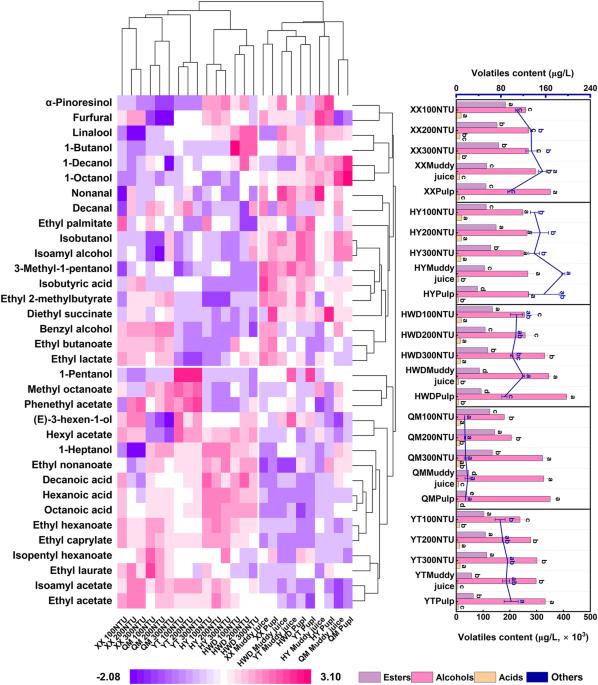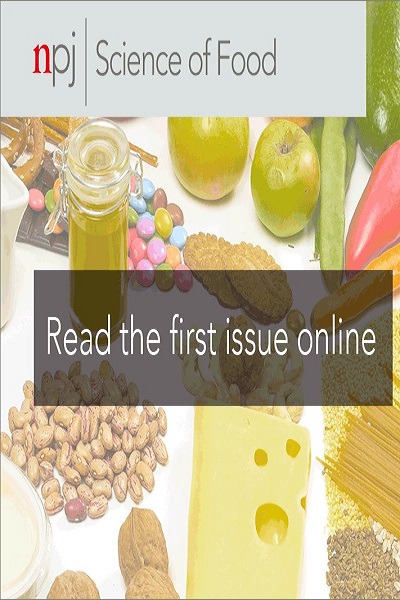葡萄汁澄清处理对猕猴桃葡萄酒化学和感官特征的影响。
IF 6.3
1区 农林科学
Q1 FOOD SCIENCE & TECHNOLOGY
引用次数: 0
摘要
本研究考察了不同澄清处理对 5 个不同猕猴桃(Actinidia deliciosa)品种酿制的猕猴桃酒的理化性质、挥发性化合物和感官属性的影响。澄清度对理化参数的影响很小,包括残糖、乙醇、挥发酸、可滴定酸度("秦美 "猕猴桃品种除外)和 pH 值。然而,用未澄清果汁(泥汁和果肉)酿制的葡萄酒比用澄清果汁酿制的葡萄酒甘油含量高。聚类热图和主成分分析(PCA)表明,用澄清的猕猴桃果汁酿制的猕猴桃葡萄酒酯含量较高,而用泥浆果汁和果肉酿制的葡萄酒酒精含量较高。定量描述性分析(QDA)表明,澄清果汁葡萄酒在纯度、典型性、协调性、浓郁度和新鲜度方面优于泥浆果汁葡萄酒,而在口感酸度方面的差异可以忽略不计。此外,与泥状果汁和果肉葡萄酒相比,澄清果汁葡萄酒具有更多猕猴桃葡萄酒的特征香气(猕猴桃、西番莲果和菠萝),而泥状果汁和果肉葡萄酒的青草味更浓。虽然 100-NTU 猕猴桃汁发酵酒在聚类热图和 PCA 中没有显示出优势,但它在 QDA 中显示出更好的新鲜度、典型性和浓郁度,以及更多的百香果香气。根据正交偏最小二乘判别分析,A. deliciosa '徐香'被认为是最适合酿造的品种。这项研究为提高优质猕猴桃葡萄酒的生产提供了重要的启示。本文章由计算机程序翻译,如有差异,请以英文原文为准。

Impact of must clarification treatments on chemical and sensory profiles of kiwifruit wine
This study examined the effect of various clarification treatments on the physicochemical properties, volatile compounds, and sensory attributes of kiwi wines produced from five different kiwifruit (Actinidia deliciosa) varieties. The degree of clarification had a minimal impact on physicochemical parameters, including the content of residual sugar, ethanol, volatile acid, titratable acidity (except for the kiwifruit variety ‘Qinmei’), and the pH value. However, wines made from unclarified juices (muddy juice and pulp) displayed a higher glycerol content than those made from clarified juices. The cluster heat map and principal component analyses (PCA) demonstrated that kiwi wines produced from clarified kiwi juices possessed a higher ester content, whereas muddy juice and pulp wines contained elevated levels of higher alcohols. Quantitative descriptive analysis (QDA) indicated that clarified juice wines outperformed muddy juice and pulp wines in terms of purity, typicality, harmony, intensity, and freshness, with negligible differences in terms of palate acidity. Moreover, the clarified juice wines featured more characteristic kiwi wine aromas (kiwifruit, passionfruit, and pineapple) compared with that of the muddy juice and pulp wines, which exhibited an increased grassy flavour. Although the 100-NTU kiwifruit juice-fermented wine did not show an advantage in the cluster heat map and PCA, it presented better freshness, typicality, and intensity in the QDA, as well as a more passionfruit aroma. Based on the orthogonal partial least-squares discriminant analysis, A. deliciosa ‘Xuxiang’ was deemed to be the most suitable variety for vinification. This study provides crucial insights for enhancing the production of high-quality kiwi wine.
求助全文
通过发布文献求助,成功后即可免费获取论文全文。
去求助
来源期刊

NPJ Science of Food
FOOD SCIENCE & TECHNOLOGY-
CiteScore
7.50
自引率
1.60%
发文量
53
期刊介绍:
npj Science of Food is an online-only and open access journal publishes high-quality, high-impact papers related to food safety, security, integrated production, processing and packaging, the changes and interactions of food components, and the influence on health and wellness properties of food. The journal will support fundamental studies that advance the science of food beyond the classic focus on processing, thereby addressing basic inquiries around food from the public and industry. It will also support research that might result in innovation of technologies and products that are public-friendly while promoting the United Nations sustainable development goals.
 求助内容:
求助内容: 应助结果提醒方式:
应助结果提醒方式:


